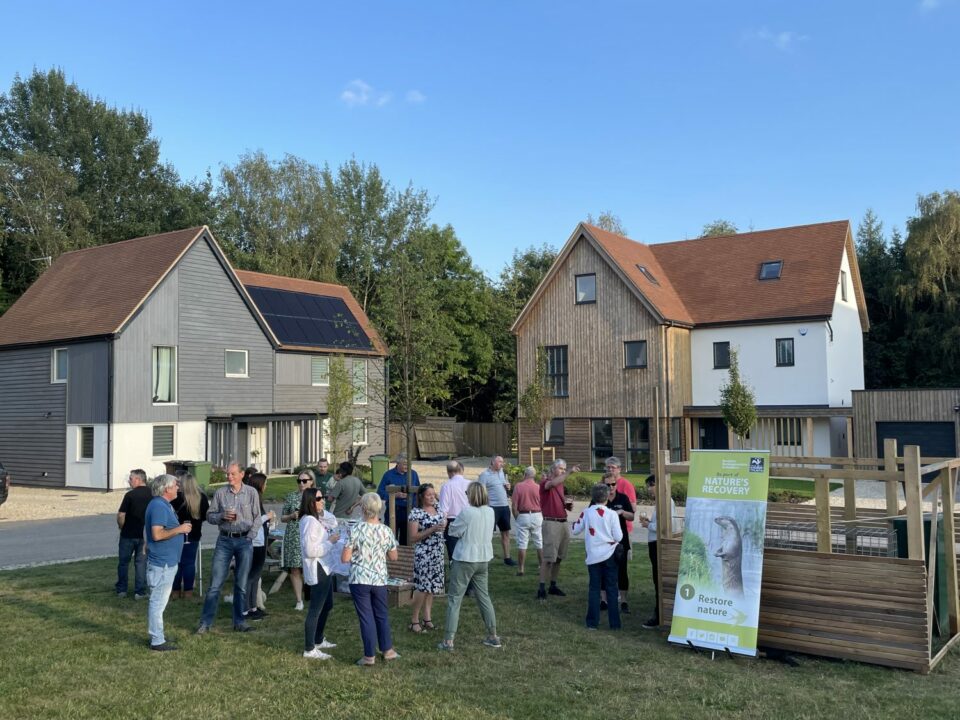- Case studies
- Springfield Meadows

Springfield Meadows
A smart and fair neighbourhood project optimising clean energy generation
The Springfield Meadows trial formed part of Project LEO’s Smart Fair Neighbourhood (SFN) projects. These were six sets of local trials that explored how Smart Community Energy Scheme (SCES) business models can sit at the heart of a smart, low-carbon, locally balanced energy system, creating opportunities and benefits in an equitable and fair way for everyone.
What was the purpose of the Springfield Meadows trial?
Springfield Meadows is a relatively new-built climate-positive housing development that has won several awards. Built by Greencore Construction, the 25 houses in the development have been built to Passivhaus energy standards which are better than zero-carbon, making them climate positive. They are also net-zero energy and that means really comfortable living with low bills. The homes include air source heat pumps, solar PV and some with EV chargers and household storage batteries.
The issue encountered by developers and residents came from the homes’ extraordinary capacity to generate solar electricity. The development was generating more electricity from the solar panels than could be safely exported to the local distribution network operator (DNO), Scottish and Southern Energy Networks (SEEN). This was because the Business-as-Usual planned infrastructure from Distribution Network Operators would not suffice. So, SSEN had to temporarily restrict electricity exports from 11 of the properties in the development, meaning they were unable to export the excess electricity generated from their solar panels.
An obvious solution to handle the increased exportation from PV would be to install more infrastructure, i.e. add another transformer, but this would incur additional costs to bill payers, create more embedded carbon and wouldn’t deliver a smart solution that could be replicated for low carbon developments elsewhere.
Therefore, the aim of this SFN was to find a smart solution that would enable all property owners in the estate to export generated electricity in a smart and fair way, without costly upgrades to the grid.
What were the available solutions?
To begin, a technical assessment of the challenge was conducted by Baringa, which included identifying how much solar generation was being curtailed, the specification of the development‘s connection to the local network, the specific network performance concern that SSEN had, which led to restrictions being put in place.
Solutions were brainstormed with the experts involved and captured in pro-forma summaries to allow them to be easily discussed, compared and contrasted by the project partners. However, it would be Greencore Ltd, as developers, to choose a solution that would work for them, though the DNO, and SSEN, would also have to agree.
The solutions brought forward had to:
- Have a reasonable timeframe of 3-6 months
- Avoid network reinforcement and cost less
- Be scalable i.e replicable to other developments or for retrofitting
- Be easy to deliver
- Not be overly complex
- Be smart and fair and meet the Low Carbon Hub’s ethical framework
Through identifying innovative solutions, the aim was to reduce the need for additional infrastructure in the future, which is estimated to cost billpayers and the government £47bn per year by 2050.
The table above shows the ten options assessed by the team for the Springfield Meadows load-sharing options analysis: the options shown in green are those being pursued with those in amber being the fallback option. This was reduced to a shortlist of five for SSEN to review (see Table below).
Of these options, SSEN were most interested in the solution ‘Local Load Balancing’ suggested by Power Transition. This involves using the energy assets at Springfield Meadows flexibly to ensure that the export thresholds of the substation are not exceeded.
Making this solution workable would require an aggregator or flexibility provider to control assets at the development (such as air source heat pumps, appliances, electric vehicle chargers and domestic batteries). Power Transition did a desktop study on this option to establish whether it’s possible for this type of energy flexibility to remove the need to reinforce the infrastructure. For this study, half-hourly household energy data going back one year was required.
As part of the trial and to enable the study to succeed, thirteen Springfield Meadows homeowners signed a consent form allowing Low Carbon Hub to get this usage and generation data from their suppliers. Of these, nine have no export and three are able to export surplus electricity generated by the solar panels on their roofs.
Who was involved in the trial?
As with all of the Project LEO trials, the collaboration of a number of different groups was key to the success. Low Carbon Hub was responsible for managing and delivery of the project.
Greencore Ltd was the developer of the Springfield Meadows estate and project sponsor Baringa the energy and flexibility services consultants and Scottish and Southern Electricity Networks (Innovation team) acted as decision-makers on our trial solution as local network operator. R-Eco Solar panel consultants. Active Building Centre were the trial’s decarbonisation consultants with a specialisation in low carbon buildings and grid solutions.
And of course, the Springfield Meadow homeowners and our trial participants.
What were the key learnings?
As with all the Project LEO trials, we considered the successes as well as things that didn’t work so well as valuable learnings.
In Springfield Meadows, we found what worked well was having a steering group made up of representatives from seven partners meant that the project had great expert input and buy-in. However, on the flip side, a steering group of representatives from seven partners meant it was difficult to understand who needed to make the decisions. We also found that the use of energy jargon made it difficult to establish a common language.
For the Power Transition study, it was a challenge to obtain the required residents’ historical energy data despite having permission. The energy suppliers have the information but in order to obtain it we had to have a signed letter, and provide ID evidence and the timeframes were just over two months. In the end, we asked the residents to download a special free app created by NHildebrand, called the Bright app. Disappointingly, only three residents downloaded the Bright app and accepted the additional SFN terms and conditions. This may be due to participant fatigue, after five interactions with the project team.
What were the results of the trial?
The Power Transition report titled ‘Local Load Balancing Pre-Feasibility’ gives us a clearer view of the precise issues with the Springfield Meadows development:
- the site was found to exceed its current 55kW export threshold (set by SEEN) by 757 times, so there is a significant loss of site solar-generated electricity
- an aggregated 90–100kWp export threshold would be needed to allow the bulk of the surplus solar energy (that isn’t for domestic consumption and on-site battery charging) to be exported
- overall, however, the problem of surplus energy production across Springfield Meadows is likely to diminish. This is because consumption offers better value than export, and battery and EV adoption is likely to increase progressively, plus growth in demand for cooling/air conditioning – all of this will increase site consumption and storage.
- a review of alternative solutions (as shown in the Table above) was supplied along with a roadmap that sets out the recommended approach for follow-on work to build a blueprint for zero-carbon housing developments in the future.
The trial gave us some vital learnings, but meeting the SFN’s ultimate aim of enabling the export of more solar energy generated on the Springfield Meadows development will take more time, data gathering and expertise than initially expected.
The potential solutions developed as part of the work with a range of different partners cover a very wide range, from network upgrades to community mechanisms. While we encountered many unforeseen challenges, these too provided valuable insights that will help inform and shape any future roll-out of trials of this type.
